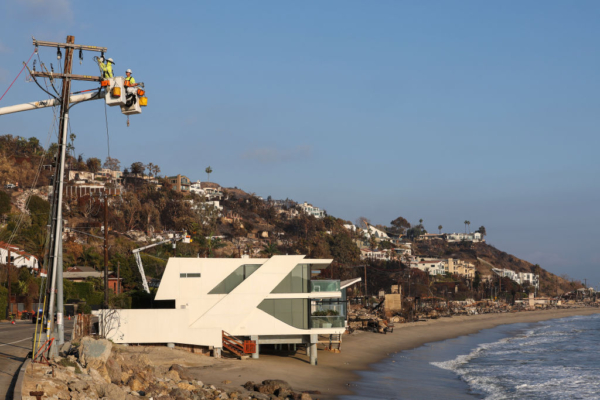The Palisades Fire, which has been burning near Los Angeles for almost a month, has now been fully contained, reaching 100% control. On February 3rd, a section of the Pacific Coast Highway (PCH) was reopened, although plans to lift all checkpoints in the fire-affected areas have been delayed due to disagreements among local officials. Residents still need to obtain permits to return home and assess the damage.
As of Monday morning, the Pacific Coast Highway is open for traffic, but the section between McClure Tunnel and Carbon Beach Terrace has reduced lanes to one in each direction, with a speed limit of 25 miles per hour.
However, Topanga Canyon Blvd remains closed between the Pacific Coast Highway and Grand View Dr. The California Department of Transportation (Caltrans) mentioned that the ongoing closure is due to fallen power poles and lines in the construction zone, as well as mud and debris on the road caused by rain on January 26.
While some roads have reopened, restrictions in the Palisades Fire area remain in place, prohibiting unauthorized access to the area.
Over the past weekend, Los Angeles Mayor Karen Bass announced the postponement of plans to dismantle all checkpoints leading to the Palisades community along the Pacific Coast Highway. Entry into the area still requires passing through checkpoints and presenting proof of residence or permits.
Mayor Bass reiterated on social media on Monday morning: “Access to the Palisades area is still limited to residents and authorized personnel to ensure safety is our top priority.”
Bass’s decision has sparked controversy online, with many criticizing the city for its policy of “prohibiting fire victims from returning home to clean up,” arguing that evacuees should have the right to return immediately. Los Angeles County Supervisor Lindsey Horvath also expressed dissatisfaction with the city’s delayed policies in a statement.
Currently, residents returning to the Palisades need to obtain permits from law enforcement, located at 1150 Pacific Coast Highway, Santa Monica beach entrance.
Though the wildfire threat is gradually diminishing, the National Weather Service in the United States predicts that starting on Tuesday, multiple atmospheric river storms may hit Southern California, leading to more rainfall that could result in mudflows and debris flow in the fire-affected areas.
Horvath stated that local government departments have entered a defensive mode to prevent further tragedies, including clearing storm drains, catch basins, and debris basins in areas vulnerable to disasters such as wildfires, and deploying sandbags along with protective barriers in the Palisades Fire and Eaton Fire areas.
She also urged the public to prepare for the upcoming storm, including clearing drainage channels around their homes, placing sandbags, and avoiding burnt areas and mountainous roads during heavy rains.
Since January 7th, Los Angeles has experienced two of the deadliest wildfires. The Palisades Fire, the first to erupt, swiftly consumed over 23,000 acres of land within seven days, destroying homes and businesses in the affluent Pacific Palisades and Malibu areas of Los Angeles.
As of February 3rd, the fire has been fully contained at 100%, but it has claimed the lives of 12 individuals. The fire has destroyed 6,837 structures, damaged 12,317 structures, including Pacific Palisades Charter High School and other schools along the fire’s path. The cause of the fire is still under investigation.
The Eaton Fire, which broke out simultaneously, has become the second most destructive and deadliest wildfire in California’s history. While the fire is also now 100% contained, it has resulted in 17 fatalities and the destruction of 9,418 structures.

